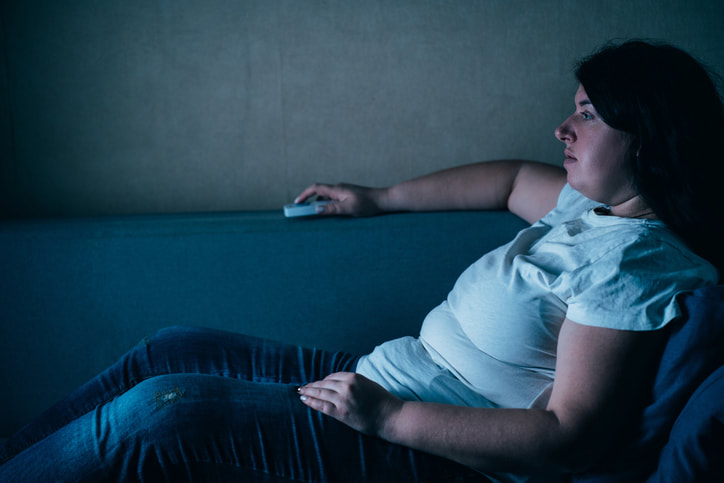|
The kids are asleep, the kitchen is clean and put away, but you aren’t super tired yet. Do you turn on the tv and watch your favorite show for an hour (or two)? If you are like most moms, we tend to justify our answer by classifying this time as “mom-time” or “filling our cup” with something we want to do after a long day at the office and then tending to our kids. But what exactly are we trading in for that extra hour of screen time? The reality is, quite A LOT. Remember when our children were babies and all the experts told us that setting up a night time routine for them was the recipe to get them to sleep through the night? If you were like me, you heeded the advice and set, like clockwork, every night a bath ritual (complete with a song), massaging, lowering the lights, nursing and a little rocking, then placing them in their beds, tucking them in, shutting off the lights and closing the door. Sound familiar? Yup, we did this for them, but never, ever did we think twice about what sleep and rest can do for us. The answer is LEAPS AND BOUNDS. When we don’t get enough sleep our bodies enter a slight state of stress. Cortisol, our stress hormone, stays elevated throughout the day making us agitated and uneasy. It also raises our insulin hormones, which if you remember is our master fat storage hormone. When your insulin levels are high, your body is in fat storage mode. Further, when it is chronically high (day in and day out), then your fat storage lever is jammed in the on position with no quick way to turn it off. Cortisol also stimulates hunger. Since your body is “stressed” (but really just tired), your brain thinks you don’t or won’t have enough energy to get through the day, so it forces you to eat. But not just ANY food, it trains your body to seek out foods that can deliver quick bursts of energy. Can you guess what those are? Yes, carbohydrates and sugars—the junk food!!! Studies have shown that a person can change their insulin sensitivity to that of a pre-diabetic in just 2 days of inadequate sleep! That extra hour doesn’t sound so great afterall, right? Here some things you can do to improve your sleep (HINT: give yourself a night time routine, mama!): Set the environment The best ambient temperature for humans is about 65°. Adults should target a room temperature of 60-65° while children and infants ambient temperatures should 65-68° because the cool air can stir them more than it can an adult. Why so cold? The human body naturally gets warmer during sleep. The body opens blood vessels which raises the body’s temperature slightly in a process called vasodilation. When you think of the purpose of sleep, which is your body’s time to repair, opening blood vessels makes so much sense because by doing so, it helps more efficiently transport oxygen and vitamins and minerals to our cells, muscles, neurons, etc. that are repairing or regenerating and filter and carry away toxins. (The human body is soooooo cool!) Turn off all the lights Studies have shown that even the smallest amount of light can effect our circadian rhythm. That’s because our bodies are biologically wired to respond to light. When our cells detect light they stimulate the release serotonin which directly stops the brain’s production of melatonin, initiating wakefulness. So, turn off all the lights in your room. Yes, even your VCR and digital alarm clock light! Shut off your devices 1 hour before bed This goes along with the tip above about hormone secretion from light. Once the sum sets, our brain responds by producing and excreting melatonin from our pineal gland. This calms us down and prepares our body for sleep. In our technology centered world this natural signaling is disrupted by our devices—ipads, kindles, phones, computers and TV. These light emitting devices keeps our serotonin production high which keeps us artificially awake but our bodily systems tired and ready for repair (which is essentially what rest is for). A good rule of thumb is to turn off your devices at least 30 minutes before bed—I like to recommend 1 hour so that your body can really prepare for rest. Front load your sleep Well, I’ll just sleep in on the weekend or stay in bed a little longer in the morning. Unfortunately it doesn’t work this way. Studies have shown that it is much more effective to front-load your sleep and get to bed earlier. Because our bodies naturally work with the rising and setting of the sun, once the day begins, chances are your body will be in a wakeful mode. Have you ever stayed up late and then still woke up at your normal time the next morning no matter how hard you try to sleep in? This is a direct example of your body doing its natural job. Try going to bed 30 minutes earlier than you normally do. Do this for a week or two and then gradually increase the time until you’ve found a nice sweet-spot in your sleep quality. Go for a walk after dinner Studies have shown that a quick 20 minute walk after dinner each night can increase the quality of your sleep—which is a great thing. Ecotherapists claim that a walk can help impact the production of neurotransmitters like melatonin which can encourage more deep sleep. Walks have also been shown to reduce stress and work to reset your circadian rhythm. So instead of dessert, try going on a walk after dinner! Monitor your sleep with an app Has this really struck a cord for you? Know that not everyone needs a full 8-9 hours of rest a day. Just like with everything else, people’s needs are individual. Some need 6 others 9 and if you have been chronically sleep deprived you may need more in the beginning and then your needs may level off or taper down. The only way to know how much you will need is some experimentation and a sleep app. I use my apple watch and an app called Pillow to monitor my sleep. You can see data like resting heart rate, etc and see a relative sleep score. I am not a sleep expert, but you can quickly see how adjusting your sleep duration can have massive effects on your sleep quality. Whatever you do, do your best to make sleep (and consistent sleep) a priority. Don’t sabotage your weight loss journey by not getting enough sleep. It’s something that isn’t hard and doesn’t cost nY money to do; but it has immense implications for your total health and wellness! The ideas, concepts and opinions expressed herein are intended to be used for EDUCATION PURPOSES ONLY. These documents are published and distributed with the understanding that Arlene Santos and This Keto Family are not rendering medical advice of any kind, nor is intending to replace medical advice, nor to diagnose, prescribe or treat any disease, condition, illness or injury. It is imperative that before beginning any diet or exercise program, including any aspect of the ketogenic program, you receive full medical clearance from a licensed physician.
0 Comments
Yes, it happens to the best of us and even to the most dedicated. I often tell family and friends not to worry about what I’ll eat at a party or event. Most of the time there is a satisfactory number of primal keto friendly food options and even if there isn’t, I’ve been on this journey long enough where I’m calorically efficient and not easily swayed by sweets or treats. The problem mostly lies with my clients who are newly keto or primal. The temptations run high when you’ve just started your keto transition. This is because your body still has strong psychological attachments to food—and not only that, there’s a HUGE chemical component too that is almost impossible to escape by pure will alone. You see our bodies function and react based on the signals it receives from stimuli like sights, sounds, environmental triggers and yes, food! The food we eat trigger hormonal cascades throughout our bodies influencing how we react. For example, eating large amount of carbs and sugars will signal an insulin cascade as the body reacts to remove excess sugar from our bloodstream. When insulin does its job too well, your insulin levels plummet and you get the all to familiar hangry which forces you to gorge on some more pizza, snacks, etc. The glucose also bonds to similar “happy” receptors in our brain and stimulates the brain to release dopamine and opioids; essentially eliciting a “high” similar to what you get from the use of recreational drugs. And just like with addictive substances, when these happy hormone levels plummet, your brain will crave more. Are you seeing a pattern? Your body will react to what you put in it. People that claim they are “addicted” to sugar, quite literally are because their bodies are stuck in the ebbs and flows of hormones that are too strong for our bodies to ignore. Now do you see why our society’s notion of “will power” on any diet is doomed from the beginning? You may be able to get by the first few days, maybe even the first few weeks on will alone, but eventually as your body puts more and more pressure for you to desire these foods, your will power will falter. So what happens when it does? Is your diet ruined? Have you just failed? The short answer is NO. Here’s a few things to remember when your choices were less than perfect: How much did you side step? Be honest with yourself and hold yourself accountable. How large was your treat? Was it a part if a single meal, like an ingredient? An entire meal? An added meal, like a dessert? Or was it a full day (or days) of indulgences? Depending on how large you side-stepped, what you need to do will vary. Also, if you are fat-adapted and metabolically flexible, your body may be able to “bounce” back quickly and you actually don’t need to do *anything* (HINT…This is the ultimate goal…metabolic flexibility. Pretty much a superman model where your body is so optimally tuned, a cheat meal or dessert doesn’t register a blip on your metabolic map.) Get back on track and push forward. First I like to remind my students to take a deep breath. NO you haven’t ruined your diet forever. An NO, you are not a failure. You simply made a side step and all you need to do is step forward again the next day. Have your treat meal/snack/item and then the next meal go back to primal. What if you made several side steps? Yes, it happens. Know that it may be harder to step forward with several side steps or backward steps. You entered that hormone cascade loop again so breaking it might be that much harder—but you can do it! Don’t dwell on your error. The worst thing for you to do is beat yourself up for your indulgence. Remember our hormone cascades we talked about above? Dwelling on your error and being uber critical on yourself raises your cortisol levels which make you…..eat! Yikes, so don’t dwell, move forward. Try this: Look at your upcoming week and identify areas that you may be less than perfect. Decide before the event how you want to approach the situation. Look at the menu, plan ahead and if all else fails, be ok with your situation and be confident that you can step forward tomorrow. Ride the stored fuel! Chances are a majority of your treat meals will be converted to glycogen (stored form of glucose) and stored in your liver and muscle tissues. When those coffers a full, the excess glucose converts to fat and is stored around our body under our skin (subcutaneous, soft and squishy) or around our vital organs (visceral, the dangerous fat). So what do I mean about riding the stored fuel? Well you want to force your body to burn the fat it just created. Chances are you won’t be full the next day—ever have that happen? Yup, it’s because you have stored fat and your fat cells are sending leptin hormones out that tells your brain, “We have energy. We are full.” The problem when we eat based on schedule—“It’s noon so I have to eat lunch”, vs waiting until our body sends us true signals. So begin to listen to your hunger cues and eat a bit less each meal the next day or wait an hour to have your breakfast. Burn the stored fuel! Another way to deal with your extra stored energy is to use it. Go on a morning walk and another after dinner. Exercise is a great way to burn extra energy (aka fat), but be cautious not to over do it. Excessive exercise and exercise too strenuous for your fitness level will only make you tired, run down and EXTRA hungry at the end. Intermittent Fasting Depending on your fat adaptation and where you are with primal nutrition level, you can try to intermittent fast the day following a treat meal or a larger side-step. Similar to riding your stored fuel above, intermittent fasting is a safe practice that switches on the repair and recovery mode of our bodies and will use stored fuel (aka fat) for energy! If you’ve never IFed before, I suggest you do not jump to this option. You have to work up your fasting muscle slowly so jumping in cold turkey may be doing more bad than good. Even if you do nothing special after a treat meal/side-step, the key is to step forward the next day. Get back to eating keto or primal. Get back to basics and trust that your body will level itself out within a day or two. So one treat meal here or there isn’t going derail you too much. As long as you don’t make it a habit you don’t sweat the small hiccups. The ideas, concepts and opinions expressed herein are intended to be used for EDUCATION PURPOSES ONLY. These documents are published and distributed with the understanding that Arlene Santos and This Keto Family are not rendering medical advice of any kind, nor is intending to replace medical advice, nor to diagnose, prescribe or treat any disease, condition, illness or injury. It is imperative that before beginning any diet or exercise program, including any aspect of the ketogenic program, you receive full medical clearance from a licensed physician.
|
AuthorArlene Santos is a Certified Health & Nutrition Coach and works with women and families to implement achievable nutrition plans centered around primal, nutrient dense foods that are easy to prepare, kid-friendly and delicious. She believes that every woman and mother deserves to feel energized, focused, healthy, lean, happy and confident. As purveyors of nutrition within our own households, mothers have a unique opportunity to change the definition of "healthy foods" in their families. Arlene empowers women to take back their own health, fill and strengthen their cups, so they can advocate for wellness in their families. Archives
December 2023
Categories |
SERVICES |
Recipes |
About |
CONNECT with Us |
©2019-2022 THIS KETO FAMILY ALL RIGHTS RESERVED. | PRIVACY POLICY & DISCLOSURES | CLIENT LOGIN




 RSS Feed
RSS Feed